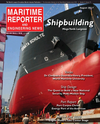
Page 27: of Maritime Reporter Magazine (August 2017)
The Shipyard Edition
Read this page in Pdf, Flash or Html5 edition of August 2017 Maritime Reporter Magazine
Balancing Ef? ciency & Security lite communications equipment on ships together. Multiple individuals on each all tied together into one network. On
By Dennis L. Bryant, allowed the collection of myriad data ship have access to the technologies. September 21, 1997, the cruiser was op-
Bryant’s Maritime Consulting and rapid ship-shore communications These individuals have widely varying erating solo about 100 miles off Cape worldwide. It also allowed for instal- levels of training and experience with Charles, Virginia. A crewmember in the
We live and operate in a complex so- ciety. That society would be impossible lation of such technologies as AIS and those technologies. engineering department, while ordering without modern computers and other ECDIS. All of these and other develop- supplies, mistakenly entered a zero as ments have fundamentally changed the A Few Examples the divisor in a mathematical equation. information technologies Those tech- nologies have largely been developed maritime industry, generally for the bet- The Aegis cruiser USS Yorktown (CG- Dividing anything by zero results in an piecemeal to address particular issues, ter. But there have been downsides. 48) was commissioned in 1984. For in? nite number. The computer crashed.
The technology requires an increasing twenty years, until its decommissioning That caused all the other computers on and for the most part they have generally level of training for the human operators. in 2004, it was one of the most power- the ship to crash. The ship totally shut achieved their particular goals. Maxi- mum ef? ciency is gained when multiple This has proven especially dif? cult for ful and sophisticated warships in the US down. Not only did the engines not technologies are joined to coordinate the maritime industry where crew turn- Navy. The continuing quest for sophisti- work, neither did the radios. The ship their work. Computers get smaller and over is high. There are multiple manu- cation, though, almost did it in. In 1996, could not send an SOS or notify its head- facturers of the same equipment, such as the Yorktown was selected to be the tes- quarters of the dilemma. It took approxi- faster, with ever-growing memory. Join-
ECDIS, and each takes a different ap- tbed for Navy’s Smart Ship program. mately 2.5 hours to get the radios back ing computers together allowed for cre- proach to providing the desired service. The cruiser was heavily computerized, on line so that a message could be sent ation of the internet. Placing small ef? -
As a result, the training received on a with an integrated control center on the to headquarters in Norfolk. Assistance cient computers and related technologies on satellites allowed for establishment piece of technology on one ship may be bridge and other computers monitoring was dispatched and the cruiser was es- of the global positioning system and largely useless on another ship. There all shipboard activity. Unfortunately, corted back to port. The Navy immedi- wireless internet connections such as is no standard method for integrating all crew training and system segregation ately declared the whole incident secret. the technologies on a ship so as to work were neglected. The computers were It was not until some months later that a
Inmarsat. Putting computers and satel- www.marinelink.com 27
MR #8 (26-33).indd 27 MR #8 (26-33).indd 27 8/4/2017 10:35:28 AM8/4/2017 10:35:28 AM

 26
26

 28
28
